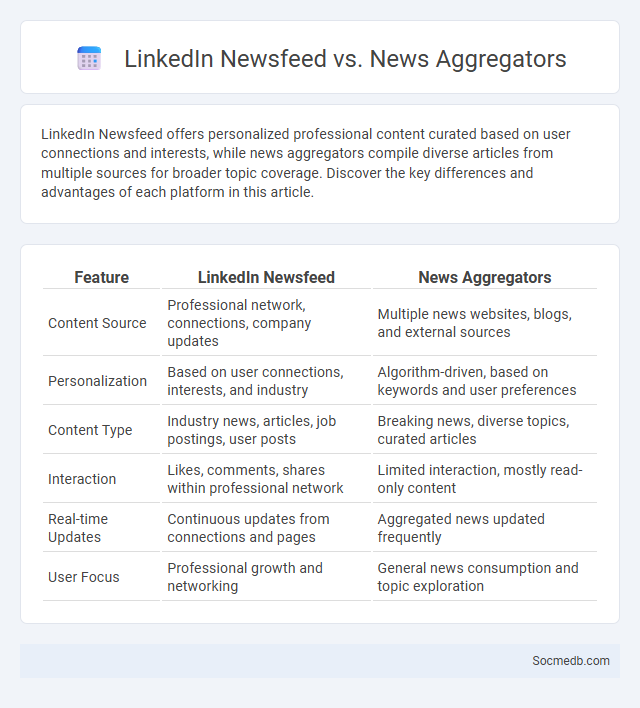
Photo illustration: LinkedIn Newsfeed vs News Aggregators
LinkedIn Newsfeed offers personalized professional content curated based on user connections and interests, while news aggregators compile diverse articles from multiple sources for broader topic coverage. Discover the key differences and advantages of each platform in this article.
Table of Comparison
| Feature | LinkedIn Newsfeed | News Aggregators |
|---|---|---|
| Content Source | Professional network, connections, company updates | Multiple news websites, blogs, and external sources |
| Personalization | Based on user connections, interests, and industry | Algorithm-driven, based on keywords and user preferences |
| Content Type | Industry news, articles, job postings, user posts | Breaking news, diverse topics, curated articles |
| Interaction | Likes, comments, shares within professional network | Limited interaction, mostly read-only content |
| Real-time Updates | Continuous updates from connections and pages | Aggregated news updated frequently |
| User Focus | Professional growth and networking | General news consumption and topic exploration |
Understanding LinkedIn Newsfeed: Features and Functionality
LinkedIn Newsfeed curates professional content tailored to Your industry, connections, and interests by leveraging advanced algorithms that prioritize relevance and engagement. Key features include personalized updates, trending industry news, and interactive posts such as polls and shared articles that foster networking opportunities. Understanding these functionalities allows You to optimize Your feed experience, enhancing visibility and professional growth on the platform.
What Is a News Aggregator? Core Concepts Explained
A news aggregator is a digital platform or app that collects and displays news articles, blog posts, and other content from various sources in one place, enhancing user convenience and content discovery. By using algorithms or manual curation, these aggregators personalize news feeds based on user preferences, interests, and browsing behavior, improving relevance and engagement. Popular examples include Feedly, Google News, and Flipboard, which optimize information consumption by consolidating diverse news into a streamlined interface.
Traditional Newsfeeds: An Overview
Traditional newsfeeds on social media platforms like Facebook and Twitter prioritize chronological or algorithm-driven content updates to keep users engaged. These newsfeeds aggregate posts from friends, pages, and groups, using complex algorithms to display relevant content based on user behavior, preferences, and interaction history. The design emphasizes real-time information flow, fostering continuous content discovery and active user participation.
Content Personalization: LinkedIn vs Aggregators vs Classic Newsfeeds
Content personalization on social media varies significantly across LinkedIn, aggregators, and classic newsfeeds, with LinkedIn prioritizing professional relevance through user skills and network activity. Aggregators utilize advanced algorithms to curate a broad spectrum of topics based on your browsing history and engagement patterns, optimizing for diversity and user interest. Classic newsfeeds rely more heavily on chronological order and broad popularity metrics, offering less tailored content but higher exposure to trending posts.
Engagement and Interactivity: Platform Comparisons
Instagram leads in visual engagement with features like Stories, Reels, and interactive polls that boost user participation. Twitter excels in real-time conversations and hashtag-driven trends, promoting rapid interaction among diverse audiences. Facebook offers a comprehensive suite of interactive tools including groups, live videos, and marketplace, fostering community building and extended user engagement.
Sources and Credibility: Who Curates Your News?
Understanding the sources and credibility of your social media news is crucial as algorithms often prioritize content from selected curators, shaping your information landscape. Reliable news curation involves transparent editorial standards and fact-checking practices that help filter misinformation and bias. You should critically evaluate the origin of news, cross-referencing reputable outlets and scrutinizing the credentials of content creators for a well-informed perspective.
Algorithm-Driven Recommendations: Strengths and Weaknesses
Algorithm-driven recommendations on social media platforms enhance user experience by personalizing content based on Your preferences, increasing engagement and relevance. These algorithms analyze vast amounts of data to predict and deliver content that aligns with Your interests, but they can also create echo chambers and filter bubbles, limiting exposure to diverse viewpoints. While optimizing content discovery, they may inadvertently promote misinformation or biased content, highlighting the need for balanced algorithmic design and user awareness.
Networking Opportunities: LinkedIn Newsfeed’s Unique Value
LinkedIn Newsfeed offers unparalleled networking opportunities by connecting professionals through industry-specific content and real-time updates. You can engage with thought leaders, join niche groups, and discover relevant job openings tailored to your career goals. This dynamic platform enhances visibility and fosters meaningful professional relationships essential for career growth.
User Control: Customization and Filtering Options
Social media platforms offer extensive user control through customization and filtering options, allowing users to tailor their feeds by selecting preferred content types, blocking unwanted sources, and adjusting privacy settings. Advanced algorithms enable personalized content delivery based on user interaction patterns, enhancing relevance and engagement. These controls improve user experience by mitigating exposure to irrelevant or harmful content, promoting a safer and more enjoyable online environment.
Choosing Your News Experience: Which Feed Is Right for You?
Choosing your social media news feed depends on your preferences for content type, frequency, and source credibility. Algorithm-driven feeds prioritize personalized content based on your interactions, enhancing relevance but potentially limiting diverse perspectives. Alternatively, chronological feeds offer a straightforward timeline view, helping you stay informed with the latest updates in real time.
 socmedb.com
socmedb.com